Namaste,
Breathing the scents of Asia, exploring a region of the world where the mountains flirt with the sky… Are you ready to explore a country where the earth greets the sky and where the blue azure of the heavens blends perfectly with the highest mountain peaks of Annapurna and Dhaulagir? Welcome to the “Forbidden Kingdom” of Mustang, formerly the Kingdom of Lo in Nepal, bordering China and the Tibetan plateau… but be patient because the Kingdom is located in a remote and isolated region of the Nepalese Himalayas where access is still restricted and foreign visitors arriving in this once “forbidden” land are required to obtain a permit and pay high fees before entering Mustang:
- First test… a brief stay in Kathmandu (a fascinating medieval city where the first, but only the first, impression is of noisy, crowded, polluted and dirty place!)
- Second, a seven-hour bus ride for “tourists” on a winding road connecting Kathmandu to Pokhara, the second largest city of Nepal. You pass the Phewa Tal Lake located at the southwest limit of Pokhara. Go rowing in a Doonga for a short tour on the lake in late afternoon as the sun starts going down.
- Third, on the tarmac at Pokhara airport a small, 18-seat Fokker aircraft is waiting for us for a short flight, or rather a jump, of 25 minutes from an elevation of 2,713 feet (Pokhara) to 8,999 feet (Jomsom). Our nose glued to the window, we admire sensational views of the Annapurna massif including the mythical peak of Nilgiri rising to 23,166 feet.
North of Jomsom, in the village of Kagbeni, we get our trek permit and start off with a short hike of 5 hours just to warm up. We walk along the banks of the Kali Gandaki River, which originates in Tibet to reach the village of Chele. What a great pleasure to be among the 2,000 privileged visitors allowed to hike in this dry, windswept, treeless and barren landscape (a wind strong enough to knock the horn off a dzo!). Because Mustang is primarily a mineral desert, it is sculpted by wind into a landscape of infinite diversity. Our gaze is lost on these complex reliefs, veined in hues of gray, ocher, and red as the red cliffs of Dakhmar, red with the blood of the demon killed by Guru Rimpoche.
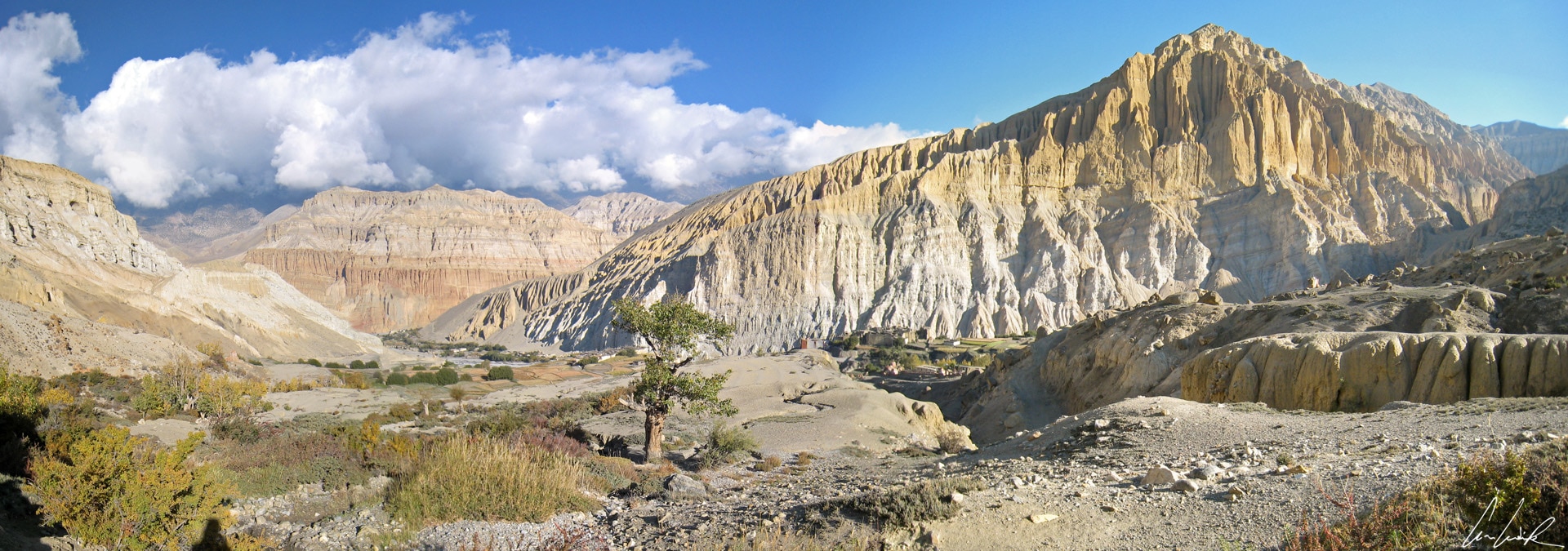
Syanboche – Moulins prayer
As Captain Haddock said at the beginning of Tintin in Tibet “I don’t mind mountains as scenery; but this passion for clambering about over piles of rocks, that’s what beats me! Besides, you’ve always got to come down again. What does it all get you anyway?” But day after day we kept walking, living in the simple rhythm of our hiking boots, the wonderful rhythm of happy wanderers. Walking up and down, but rarely sideways! Along the way, many passes are marked by colorful prayer flags, flapping in the wind (you know the famous strong wind knocking the horn off the dzos) and which also mark a break in the physical effort, a stop always greatly appreciated where we catch a glimpse of another valley!
In this dry, desert and windy climate the sight of a village is always striking. From a bend or from the top of a hill villages appear in the distance almost as mirages–whitewashed houses with tiny windows framed in black paint, flat roofs bordered by a stack of wood twigs, narrow alleys, prayer wheels such as at the entrance of Ghemi… or at the village of Syanboche. Spinning the prayer wheel is a daily gesture for Tibetan Buddhists. By rule, we walk in a clockwise direction, spinning the prayer wheel at the same time and repeating the universal mantra “Om Mani Padme Hum”..” Even if our beliefs are quite different, we feel a certain enchantment when spinning these religious objects which were obviously made with great devotion.
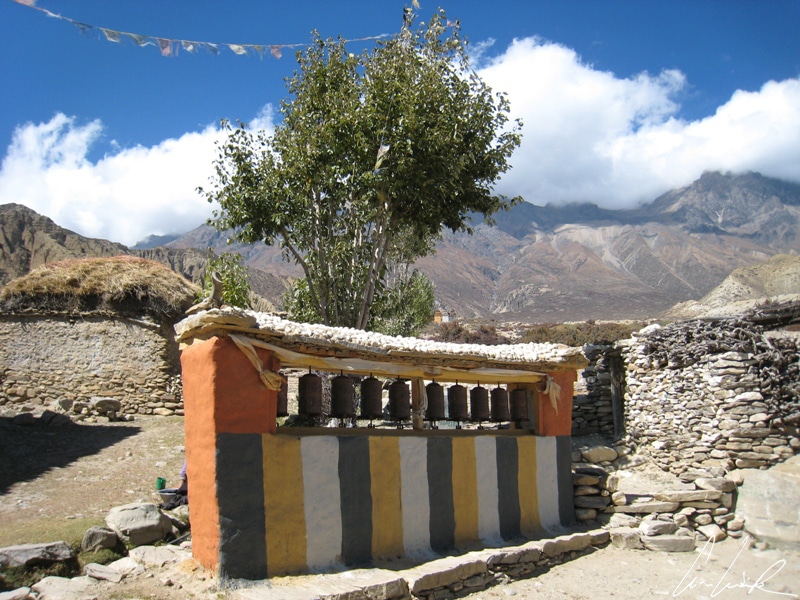
Syanboche – Moulins prayer
Terraced rice, buckwheat, wheat, barley and potato plantations encircled the village giving it a multicolored patchwork pattern, while willow trees and poplars line the irrigation canals. In the summer villages look like green oases in the desert-like landscape. In this region, people are dedicated to farming and raising livestock, mostly goats. The main concern of the population is simply making a living day after day. A life of hard labor, long hours every day bent over among the buckwheat and wheat fields. There is little time between planting and harvesting. So little time and so many fields to cultivate! It is striking to see a village in the distance from the top of a hill. It seems small and lost in the middle of infinite terraced plantations such as those near the picturesque village of Geling. Families gather many crops in the short harvest season, which provide them with food during the harsh winter. October is the harvest season: the head of the family cuts grass with a pruning knife and puts it in small piles, gradually filling the doko, an oversized conical netted basket made of bamboo. Once full, women carry the heavy dokos into the village. As for the Doko! Try to carry one filled with goat manure or grass! The first few seconds seem easy. You do not immediately feel any weight because it rests on your back and a strap runs underneath the doko and over the crown of your head, which bears most of the weight. Then suddenly severe pain radiates through your neck, as if someone were cutting your head off. Once the Doko is removed, a headache follows and lasts quite some time. Yet you have carried the doko for barely five seconds. Nepalese horses, small and stocky, carry heavier loads. They climb everywhere despite the heavy loads. Horses are also the preferred means of transport for locals, and sometimes also for tourists. Before our day of “rest” in Lo Manthang, founded in 1380 as the walled capital of the former Kingdom of Lo and now a village in the district of Manthang, we have endured 4-hour rides on these pony-sized horse. A hard day… especially for the glutes!

Ghar Gumba – Les Chortens
In another surprise for Westerners every Mustang village has its monastery, usually dominating the village from a perch on top of a rocky hill. It always recognizable from a distance by its walls coated with a dense red. The interior is often dark and cluttered with many statues of Buddha with the walls and ceilings covered with paintings of deities that our flashlights struggles to illuminate. Ghar Gompa Monastery, the oldest Buddhist monastery in Nepal, is no exception to the rule with its row of chortens and prayer flags fluttering in the wind. The chortens at Ghar Gompa are so numerous that the eyes move from one to another, counting silently 2, 5, 9, 12,15… And when the eyes get lost on the surrounding cliffs, other isolated chortens come into view overlooking the monastery like watchmen. As always the backdrop is the Annapurna massif… a majestic chain of mountains rising behind a row of prayer walls each engraved with the traditional mantra “Om Mani Padme Hum,” is especially spectacular at sunset.
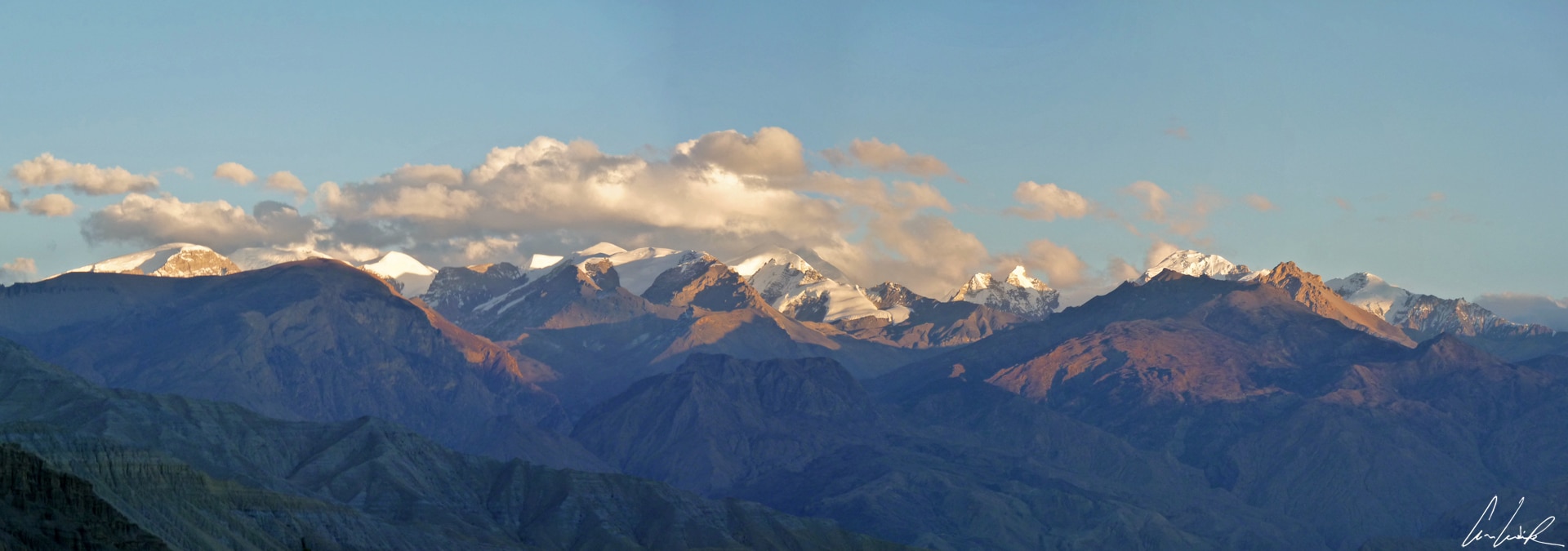
Annapurna – Sunset
White, black and ocher color the chortens and prayer walls. The Gonpo Rigsum is everywhere in Mustang: three colors painted on a wall (as in Tsarang), bas-relief or statues, three chortens in red, white, and blue keep a watchful eye on every entrance to the village. Three colors, three ochers intimately connected with the mineral landscape of Mustang. In the Mustang village beliefs inherited from animism, Rigsum Gonpo protects villages and dwellings from evil spirits belonging to the three levels of the universe, heaven, earth and the underworld. “Lha,” a divinity white in color lives in heaven. Red denotes “Tsen” evil demon living on earth, and blue or gray signify “Lu Nagas” snake-gods that living beneath the surface of the earth or in the water. Very often a dog, goat or Dzo skull hangs above the entrance door or is simply placed on a wall, as a mark of respect for the deceased animal, but also preventing the demons from heaven and earth from entering the house.
Finally to complete this glimpse of the Kingdom of Mustang and its customs, we witness the puja, ceremonies celebrated by Buddhist lamas. We can say that there are as many types of puja as lamas but the one we have saw at the Lo Manthang Monastery remains engraved in our mind: haunting chants, flickering candles, gongs and cymbals, trumpets… but unlike for Tintin in Tibet, the hats are not yellow but red…
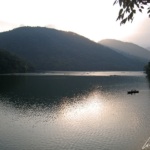
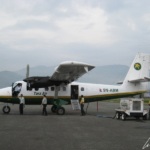
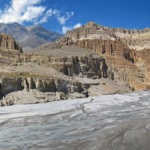
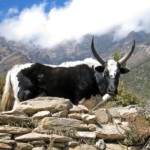
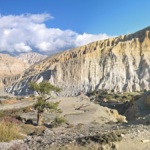

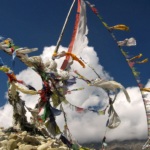
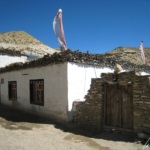
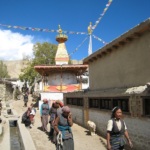
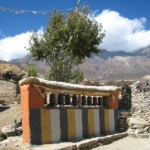
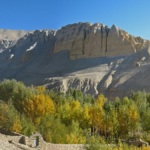
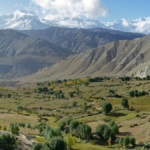
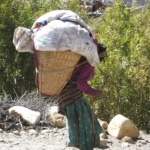

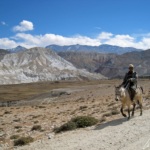
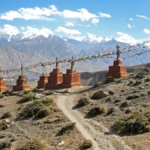

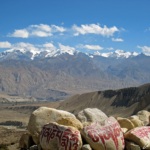
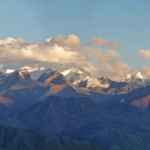
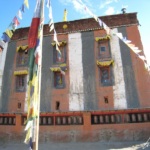
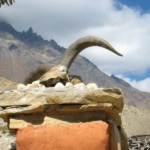
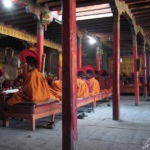


I love the way you write and your descriptions of both the trek and surrounding landscape…beautiful images too!
Thank you 🙂 Nepal is a small nation with a mighty heart… Simply because of its natural beauty and its loving and beautiful people !
Nepal is somewhere that has always fascinated me and the more I read the more I want to go. Some friends of mine have just got home this morning from completing base camp. They loved it.
Nepal is such a unique country ! First of all, the geographic area that gives Nepal a majestic view. And second, the culture – In Nepal you have Hindus and Buddhists. And of course, you got the Tibetan refugees that brought their culture with them. And so many more people from different cultures 🙂
I’ve not yet had the pleasure of travelling to Nepal – your post sums up what I would hope for… culture, meditation & legends. I found the evil spirit belief the Mustang people have particularly interesting!
Nepal has lot to offer you. This amazingly beautiful country’s visit could be life changing experience for you 🙂 Nepal has been regarded as a sacred place for hundreds of years. The tranquillity of the area will have a positive effect on anyone that is able to experience it. The people, the buildings, and the land are all symbols of serenity. In Nepal, you can truly escape !
This is an adventure that I need to add on our bucket list. Very well written and full of visuals!
Nepal is an extraordinary adventure I recommend to you ! Nepal is full of so many amazing places to see, great people to meet, etc. so see it by yourself at least once !
Nepal looks absolutely delightful – you’ve got some amazing photos!
I studied geology and those rock stratas are gorgeous to see!
If you are an avid geologist or even just an avid outdoors person, Nepal is the ultimate trekking destination 🙂
Thanks for taking me here through your writing. I loved all the pictures and specially that lone tree behind the prayer wheels 🙂
Thank you 🙂 Nepal is absolutely delightful !
Love the detail you go into about your trip!!! Looks absolutely gorgeous in your photos as well! Nepal has been on my bucket list for a while now!!
Eryn, Diaries From The Window Seat
Thank you. Travelling to Nepal change your Life ! Nepal’s picturesque natural beauty, infectious culture, and welcoming people always remains in my mind 🙂
What stunning scenery! The Himalayas are at the top of my bucket list!
Nepal has lot to offer you: the scenery, the sites, the beauty are so unique to this country ! Nepal has lot to offer you. The visit could be life changing experience for you 🙂
Nepal is high on the list. The scenery, the sites, the beauty it is all just so unique to this country. Your writing tells of such a wonderful place to visit. I would love to trek through but also spend some time exploring Kathmandu. Great post.
Nepal leaves a lasting impression on all who visit 🙂 It’s easy to spend days, or even weeks wandering around Nepal’s capital city of Kathmandu. You probably won’t venture to the top of the highest mountain in the world, but you’ll be blown away by Nepal’s scenery whether you’re snapping photos of Phewa Lake, Pokhara Valley, Bardia NP etc.
That’s awesome! When I hear Nepal, I always think of Everest Base Camp. I don’t know much about the other places so I really enjoyed reading your article and learning more about Nepal. It looks incredible. Now, I really want to go there – and not only for the Everest! 🙂
Nepal’s rich history, infinite hospitality, and majestic beauty are amazing 🙂 Nepal is a colourful jumble of pagoda-topped temples, ornate religious monuments, carved wooden Newari (native Kathmandu) architecture, chaotic streets, and majestic mountains !
Such a strange landscape, it must have been a strong experience to hike there and get to see it! Truly once in a lifetime I think 🙂 Loved the photos!
My favourite thing about Nepal ? There’s always another adventure :-).
This is so great – Nepal seems like it has so much more to offer than Everest. Would love to go to and see some of the red cliffs!
Mustang’s remote valleys are excellent for hiking 🙂 Here the mountains becomes sharper and wilder, the silent louder, the atmosphere more solemn ! The majestic valleys are dotted with villages and monasteries.
This is amazing! Absolutely loved your photos, Nepal is on my list to trek! Hopefully someday soon I’ll be able to visit 🙂
Everyone’s making a fuss why they should visit Nepal at least once in your lifetime ! Nepal is packaged for a serene and/or adventurous escape –whichever way you like it 🙂
Wow. Amazing photos. Kathmandu is on my list. I hope to get a 24-hour layover in Shanghai when I do that since airfares are expensive. LOL. Did you get culture shock? How do locals treat solo female travelers? Anyway, I love the photos. Pinned it 🙂
Nepal is absolutely beautiful ! The local Nepalese are brimming with warmth and hospitality. Whether you’re interacting with your porters or bargaining prices with the local vendors, there’s no denying how genuinely friendly our people are :-). Nepal has interesting and diverse mix of indigenous tribes who live from the city of Kathmandu to the remote areas of the Himalayas. Interacting with the local Nepalese provides a glimpse of their lifestyle, beliefs and traditions that will surely enthrall you.
Hi, I am considering trekking in Mustang this September. I guess you recommend it right? Did you get the permit there? Can you recommend a guide? Any further tips would be very much appreciated. Thank you so much
Namaste! Trekking to Mustang is a rare privilege 🙂 Mustang is one of the less known trekking destinations of Nepal. It is a mystical and culturally rich region that is excellent for summer trekking. The region is filled with many historically significant sites. The hills are eroded, and the rock formations of the region are a beauty to behold in themselves. I booked the trek with the help of the local agency http://evasiontrekking.com. Chandra & Bhim had organized a wonderful journey for us.
Thank you so much for your inspiring comment and tips.